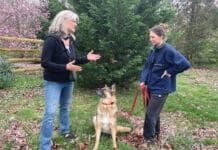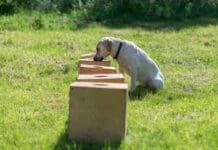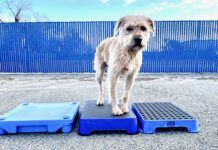Training, says Massachusetts dog trainer Donna Duford, should be fun, not work. Her seminars are such upbeat, tail-wagging events that the dogs seem to be having a party. Look closer and you’ll see a serious class, with participants taking notes as Duford reviews the laws of learning and defines classical conditioning, operant conditioning, positive and negative reinforcement, positive and negative punishment, continuous and variable reinforcement schedules, and other fundamentals of behavioral training. An internationally recognized lecturer, consultant to rescue groups, and former co-director of the exclusive dog training program for Tufts Veterinary School, Duford brings the theories of behavior modification to life with lively demonstrations.
“The secret to getting your dog to do what you want,” she says, “whether it’s learning a new trick, stopping an unwanted behavior, or improving performance for competition, is to understand why dogs act the way they do. Dogs are honest, and they do their best to communicate with us.
“Dogs do what works,” she continues. “They are obedient to the laws of learning. If you want your dog to do something, find a way for it to make sense to her, and she will respond. Dogs are easily distracted by the world around them. You have to be more exciting than the floor, other dogs, someone else’s treats, and all the other sights, smells, and sounds that compete for attention. Once you understand the laws of learning, you can break any behavior into its component parts and understand it from your dog’s point of view. As soon as you present what you want in a way that makes sense to your dog, it’s easy to change her behavior.”
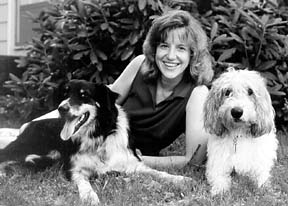
Duford, best known for her work in musical canine freestyle, the new sport of dancing with dogs, is the author of Agility Tricks for Improved Attention, Flexibility and Confidence. Don’t let the title mislead you. Her book’s tricks and the lessons they teach are just as valuable to obedience competitors, show dogs, therapy or service dogs, canine athletes, and family pets. At a recent two-day seminar sponsored by Skyline Agility Club in Haverstraw, New York, Duford showed how correctly timed positive reinforcements can be used not only to improve the performance of dogs competing in agility but also, to solve problems of every description.
Find the key to YOUR dog
“There is no single training strategy that works for every dog,” Duford told the group. “If your dog isn’t motivated by food, you won’t accomplish much with treats. The same is true for toys, praise, petting, and other rewards. Some dogs are excited by movement and like to chase things, or they love to run and play. Some are chow hounds. Some love to carry a toy. You have to find what works for your dog – or more accurately, what reward your dog will work for. The more your dog wants something, and the more clearly he understands that the right behavior will bring that reward, the faster he’ll learn.”
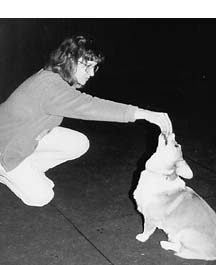
Dogs respond in different ways to physical manipulation, says Duford. Some are helped by gentle physical prompts, but others are stressed by tugging, pushing, pulling, and physical positioning. If your dog dislikes or is distracted by physical handling, use other methods. Some dogs enjoy learning new things and are willing to try just about anything, while others find the learning process stressful and work best with short training sessions, frequent positive feedback, and frequent repetition.
Emotional sensitivity is another consideration. Sensitive dogs are like sensitive people; they take everything personally! “It takes patience and understanding to train sensitive dogs,” says Duford, “because they are affected by voice, mood, facial expression, and body language. Their training works best when you give lots of positive reinforcement and keep your mind on what you’re doing because insufficient encouragement, outside distractions, or your own impatience can cause a sensitive dog to shut down and stop working. Less sensitive dogs are often easier to train because they bounce back no matter what mistakes you make.”
Another way in which dogs are different is in their response to cues and signals. Some dogs are more attentive to sound and focus their attention on voices and other auditory cues, while others are more visual and do better with physical signals.
“By far the easiest way to train a dog,” says Duford, “is to observe its natural behaviors. Most dogs already do some version of what you want. It’s just a matter of capturing and expanding on that behavior.” Once owners take the time to understand what motivates their dogs, says Duford, they can plan a sensible training schedule that incorporates all of this information. “In general,” she says, “dogs do best with short training sessions. An hour-long class is convenient for people, but dogs learn faster in five-minute sessions scattered through the day. In fact, too much training can be counterproductive.”
Shaping behavior
Donna Duford’s seminars have a party atmosphere because dogs and handlers use treats, praise, and other rewards to explore positive reinforcement. “To capture or shape a behavior,” she says, “you need a way to communicate quickly.” Duford uses a hand-held clicker because it pinpoints timing exactly, but she uses other cues as well.
“I like the word ‘yes’ because it’s easy to remember, appropriate, and easy to pronounce,” she says, “but you can use another word or a visual cue. Whatever you use, start by showing your dog that it means something positive.” This exercise involves food treats, toys, and other motivating rewards. Give a click or say “Yes!” while handing your dog a treat or toy, then repeat it until he associates the sound with a reward. No wonder tails were wagging around the room.
“A conditioned reinforcer is anything you pair with a primary reinforcer,” Duford explains. “The conditioned reinforcer is the cue. The primary reinforcer is whatever your dog enjoys enough to work for.
“To create a conditioned reinforcer, present it first. This means click or say yes, then immediately give the primary reinforcer, which is the treat, toy, or whatever your dog wants. Repeat this several times, then wait for your dog to look away and focus on something else. Click or say yes, and if your dog comes back and gives you an attentive look, she is making the connection. As soon as she associates the two stimuli or events, you have started training.”
In the seminar, Duford worked with dogs of every age and description. To teach an exuberant Portuguese Water Dog to nod, Duford waited for his head to dip even a small amount, then she clicked and gave him a treat. Soon the dog was bobbing his head so enthusiastically that everyone laughed and applauded. Then he began prancing forward and back while bobbing his head. “I have mixed feelings about this,” Duford told the crowd. “Freestyle is my first love, and this dog is a natural dancer. If this were a freestyle seminar, we’d almost be ready to choose the music. But today all I want is a nod of the head, so I won’t reinforce the dance steps. I’ll just ignore them. Because prancing doesn’t generate any clicks or treats, he’ll soon stop.” As though he understood what she was saying, the dog stood still, nodded his head, and wagged his tail as soon as this simpler behavior produced a click and treat.
Timing, as Duford demonstrated, is everything. “For a reinforcement to be effective,” she says, “it must be immediate. A reward given too late or too early won’t just fail to reinforce the desired behavior, it can reinforce something else entirely. Your dog will focus on whatever she was doing when you gave the reinforcement, and that may not be what you intended at all.” Duford recommends alternating reinforcers (a clicker, the word yes, verbal praise, visual signals, and other reward indicators), so you always have a way to communicate quickly and efficiently.
At the beginning, follow the cue with a reward every time, but when a behavior is well established, reward every other time, then on a random schedule.
“If you and I get the same reward every time we do something, like when we turn on a light switch or put money in a Coke machine, it becomes a mindless routine,” says Duford. “If we don’t get the reward we expect, we know the machine is broken or the power is off and we stop trying. But if we get a positive reward only some of the time on an unpredictable schedule, like from a slot machine, we’re more likely to repeat a behavior in hopes of getting a prize. Dogs respond the same way.”
This is why random reinforcement works so well to improve performance. When dogs are motivated to get something that might come on the next try, they try harder.
“If you want speed, wait until your dog moves faster or sooner,” says Duford, “and reward that. If you want a different improvement, like a deeper stretch, higher head position, or straighter body alignment, reward that. Reward familiar behaviors on a random schedule, but reward improvements as soon as they take place. And if the improvement is significant, increase the reward by giving a jackpot, which is a bigger or better prize than usual.”
Teaching fun tricks
Tricks are amusing, but according to Duford, the lessons they teach build a sound foundation for serious training and problem solving. Teaching your dog a new trick requires careful observation and quick responses. The more accomplished you become in timing rewards, finding the right rewards to motivate your dog, and matching your training methods to your dog’s personality, the easier it will be to tackle anything from her entry to an agility course’s weave poles to improving her retrieve or come-when-called command.
Using your hand or an object as a target is an easy way to get started. Most dogs will sniff a hand held out to them. As soon as your dog’s nose touches your hand, give a reward. Repeat this until your dog turns to touch your hand wherever it is. If your dog loses interest, make your hand more interesting by holding it behind your back, inspecting it, talking to it, kissing it, or pretending to eat something from it. Using one hand as a target helped seminar participants teach their dogs how to turn in circles, spin, shake their heads from side to side, bow, and walk while weaving in and out of their owners’ legs.
For tricks in which the dog was further away, they used a small piece of transparent plastic as a target. Other popular targets are sticks or wands. “I like transparent plastic,” says Duford, “because it’s hard to see, which makes it easier to eliminate once it’s no longer needed.” Throughout the seminar, she emphasized the importance of removing targets, rewards, and other aids as soon as possible. “Some trainers are systematic,” she says, “and they follow a scientific schedule. I’m fond of shortcuts and use them whenever possible. If your dog doesn’t need something any more, why use it? Try doing without it once or twice, and if she doesn’t understand what you want, go back to using the target, lure, or reward until she does.” Duford is quick to raise her standards. As soon as a dog seems to catch on, she withholds the conditional reinforcer, which motivates the dog to repeat the behavior faster, more decisively, or more often.
“When you and your dog understand this approach to training,” she says, “it’s incredibly exciting. It’s tempting to keep adding one more thing or try the behavior one more time, but the best you can do is keep the session short and stop while you’re ahead. As soon as your dog seems confused, tired, slow, or stressed, do something simple and end on a high note.”
A step backward can help
Duford emphasizes the importance of temporarily lowering your standards whenever you introduce something new. “Your puppy may have learned to sit on the living room rug,” she says, “but take him outside and he’s clueless. That’s because the environment is completely different, and he’s distracted. Whenever you make a trick more complicated or introduce a new distraction, your dog may seem to forget the behavior. Be patient, give him lots of praise and rewards, and lower your criteria until he catches on again.
“Focus on one thing at a time,” Duford advises. “If you’re working on speed, ignore everything else, even if the dog is out of position. When she’s moving faster, go back to body alignment, understanding that as soon as you do so, her speed may suffer. Ignore speed until her alignment improves, then return to speed. With each change of focus, lower your standards. Click for small improvements. The same is true for distractions, which is why it’s important to be patient when your dog is working in a new location and contending with new sights, smells, and sounds.”
To those who felt frustrated when their dogs’ attention wandered, Duford asked whether any had ever walked into a room and forgotten why. This produced nods and chuckles. “Or have you ever driven your car from one place to another with no recollection at all of how you got there?” More laughter. “Maybe you even drove to the wrong place,” she said. “Were you being willfully disobedient?”
Relax, she says. Forgive your dog, forgive yourself, and enjoy each other. If you aren’t accomplishing anything, take a break. It’s better to interrupt a training session and try again later than insist that the dog repeat an exercise that isn’t working.
Wave hello!
Waving one paw in the air is a fun trick that impresses people, gives the dog something useful to do, provides a healthy stretch, and illustrates the versatility of Duford’s approach.
She explains – and better, quickly demonstrates with a student’s dog – how to master the wave with one paw, and then suggests ways that you could build on the simple behavior. When the dog can wave with either paw, she suggests, have her do it while standing rather than sitting. Then have her do it lying down. Teach your dog to give both paws at the same time. Have her wave when you give a visual signal by itself or a voice command by itself. Or work on distance. If she waves reliably at three feet, step back and try six or ten feet, or give the command from across the room.
“My dogs never know what to expect,” says Duford, who lives with a Border Collie and Petit Basset Griffon Vendeen. “I’m always trying something new, or trying to get them to do something faster or better. Both of them offer all kinds of behaviors because they know something will earn a reward sooner or later.”
Solving problem behavior
To Donna Duford, problem behavior is simply an unsolved puzzle. “The behavior, whatever it is, makes sense to the dog,” she explains. “It’s the person who hasn’t figured it out yet.” Whether the problem is house training, bad manners, separation anxiety, incessant barking, or a fear of the see-saw on an agility course, Duford approaches it systematically.
“We think of going to the store as a simple operation,” she says, “but stop for a minute and think of all the steps involved. You put appropriate clothes on, get your car keys and whatever else you need, check your list, go out the door, lock the door, walk to your car, unlock the car, get in, adjust the seat, turn the radio on, adjust the rear-view mirror, put the key in the ignition, turn the engine on, and release the brake – and you still haven’t gone anywhere. A lot of behaviors are involved in taking you to the store, and each of them can be examined in detail. When you’re analyzing a dog’s behavior, you have to think in similar terms.”
Once you isolate whatever triggers the behavior you don’t want, you can replace it with something else. A dog that charges the door whenever the doorbell rings can be rewarded for holding a quiet down/stay of increasing length and increasing levels of noise distraction. A dog that whines when his owner goes out of sight can be rewarded for staying quiet for two seconds, then five, then increasingly long periods.
“When training is the problem,” says Duford, “it’s usually because the handler is trying too much too fast or is simply inattentive. Break the trick or command into small components and reward these little things instead of insisting on a complex finished behavior. Many trainers raise their criteria too rapidly, before the dog really understands the command, or they complicate the picture by asking for several things at once. Remember to work on one component at a time, and eventually the pieces will come together. Sometimes trainers raise their criteria without meaning to, such as when they try a trick outdoors for the first time. Go back to the most basic parts of the command and start from scratch.
“When a specific behavior is a problem,” she says, “you have to examine it from the dog’s point of view as well as your own. A dog will repeat a behavior that served a useful purpose in the past, even if the situation that caused it happened only once or no longer exists.”
In the agility seminar, Duford sometimes sounded like a detective, asking owners detailed questions about what, when, how, and where a problem occurred. The same approach that worked for these agility competitors works for household pets and dogs in other circumstances.
“I don’t claim that every owner can solve every behavioral problem with fun training methods,” says Duford, “but for most dogs and most people, learning tricks with positive reinforcement can transform the dog/handler relationship and lead to all kinds of exciting adventures. It’s an excellent place to start.”
-By CJ Puotinen
Author CJ Puotinen is an herbalist, holistic pet care expert, the author of Encyclopedia of Natural Pet Care, and a frequent contributor to WDJ.


